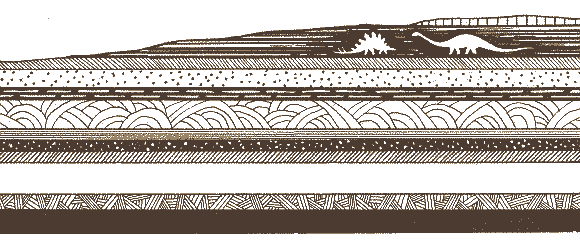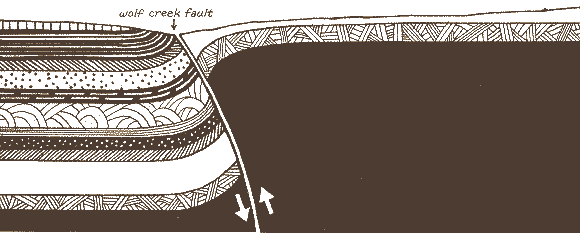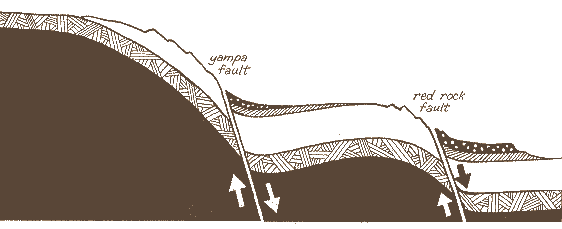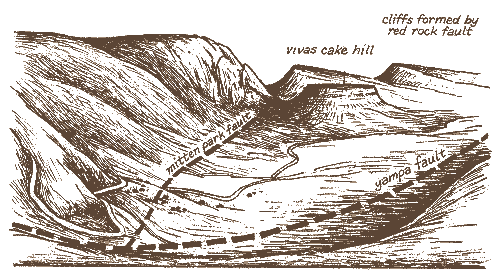
Welcome to Dinosaur National Monument. Despite the name, there's more to the park than dinosaurs, and the purpose of this guide is to introduce you to the other half of the park - the canyon country of the Green and Yampa Rivers. Along the 31-mile (50- kilometer) drive to Harpers Corner, you will see a land very unlike that which the dinosaurs roamed, yet not so different in some ways. Rock and weather, plants and animals interact today just as they did in the past. We hope that this tour will help you understand these interactions, and your relationship to them.
Numbered posts at the roadside correspond to the numbered paragraphs in this booklet. A mileage figure listed at each stop shows its distance from park Headquarters, where the trip begins. Kilometers are given in boldface.
For a safe as well as pleasant trip, please take a few precautions. Check your gas, oil and water before starting - there are no facilities along the road other than picnic sites and pit toilets. Observe posted speed limits, and do not make sudden stops or park on the traveled portion of the road. If stopping (never on a curve or other blind spot), pull as far to the side as possible but remain on the road surface. Be alert for deer and other wildlife which may cross the road unexpectedly, especially during the early morning or late afternoon and evening. In spring or fall, be wary of sudden storms which can produce adverse road conditions at higher elevations. If you plan a side trip on the unpaved Echo Park or Yampa Bench roads, ask first at Headquarters about road conditions. Unpaved roads in the area are generally impassable when wet.
Allow about 2 hours to drive to the end of the paved road and back, plus another 2 to 21/2 hours if you walk the Plug Hat and Harpers Corner Trails.
As you can see on the map, most of the Harpers Corner road lies outside the main body of Dinosaur National Monument (though the road right-of-way is park land). If you'll take the time to look closely, however, you should find that the land, its inhabitants and its history are equally interesting on either side of the boundary.

The trip to Harpers Corner is a journey into the geologic past, beginning in rocks from the close of the Age of Dinosaurs, and ending in much older rocks. Each rock layer represents an environment of the past, and though all the rocks along the first part of the road date from dinosaur times, only one layer - the Morrison Formation - contains dinosaur fossils (and none here to equal the great number of bones found at the Dinosaur Quarry, 30 miles west). Most of the rocks formed from the mud and sand of seas, deserts, or other habitats where dinosaurs just weren't at home.
These sediments were laid down in horizontal layers, but here Earth's crust has buckled, tilting the rocks and lifting them far above sea level. At the same time, erosion - with water, ice, wind and gravity - has been wearing them back down, peeling away layer after layer, revealing the story of the past. The softer rocks erode more rapidly than the harder layers, producing the series of narrow valleys and ridges that border this part of the road.
You may laugh to hear this called a forest, but these junipers and pinyon pines form the woodlands best adapted to much of the and West. Tall, broad-leafed trees cannot survive on this dry upland, for any water they could take up through their roots would soon evaporate from their leaves. The pinyon's needles and juniper's tiny scale-like leaves expose little surface to the dry air, enabling them to conserve water - a good example for people to follow in this thirsty region.
Water, though, isn't the only factor that rules plant life. The pinyon-juniper forest thrives here, but disappears in places farther along the road. Why? Changing rock layers: the trees need loose, sandy soil, such as sandstone forms, and can't tolerate the clay and alkaline minerals in shale. Maybe you've never met a talking tree before, but these can tell you quite a bit about the land and climate!
Charred tree skeletons are silent reminders of a lightning-caused fire which swept this area in 1972. This one was put out by man - but what of many such fires that must have occurred before man began to control them? Forests have survived, and natural fire should be regarded not as an enemy, but as a normal ecological force, neither all good nor all bad. True, fire destroys some life, bares the soil to erosion, and leaves a somber, blackened scene. But not forever, because new plants and animals will gradually replace those that were lost.
Here, fast-growing grasses have reclaimed the land from the trees, so the fire has improved the range for grazing (which is the main use of the land around the park) - and perhaps in a more natural way than the chains and bulldozers often used for range-clearing elsewhere.
Apparently some early traveler thought of a derby when he saw the rock ahead, and named it Plug Hat Butte. The buff-colored Entrada and Glen Canyon Sandstones form the "crown" and "brim;" the Carmel Formation makes the red "hat-band." As you drive around the butte, look for sweeping, crisscrossing lines in the sandstones: sloping layers of sand grains that say these rocks were once windblown dunes. In contrast, the level red layers probably originated as mud and salt-like deposits along an ocean shoreline. From dunes to sea to dunes - dramatic as they seem, such changes happened many times in this region's past. To read the stories in the rocks is to begin to understand the immensity of time, both past and future. Plug Hat Butte will no doubt remain long after its name has been forgotten, but in time, it too will pass, as rain, frost and wind crumble the rock to sand and mud again.

Turn left into the Plug Hat Picnic Area for stops 5 and 6.
A short walk past the picnic tables to the rim will introduce you to the Colorado Plateau: the geologic region covering parts of Colorado, Utah, Arizona and New Mexico, and drained by the Colorado River and its tributaries. The scene before you is typical of the Plateau: colorful strata, flat-topped mesas and buttes (a butte is about as tall as it is wide, while a mesa is wider), and sheer-walled canyons. The landforms are angular because there is little rain, soil or plant cover to soften or obscure the shape of the bedrock, which usually consists of flat-lying strata. However, the tilted layers at the beginning of the road hint of this area's nearness to the complex uplift of the Rocky Mountains. The meeting of the Rockies and the Colorado Plateau makes a complicated geological story, but also some s pectacular scenery - as you'll discover on this journey,
In a region where rainbow-hued rocks seem to be everywhere you look, the Morrison Formation, visible in the distance, doesn't seem too special at first glance. Like the other layers, it gets its varied colors from small traces of iron, manganese and other elements. But the Morrison is best known for traces of something else - dinosaurs. Once its rocks were mud and sand on river floodplains where hundreds of dinosaurs lived and died. Probably more often than not, the animals' bodies decayed or were eaten, leaving no trace. Occasionally, though, river sediments buried some of the bones, preserving them until sand and bone alike slowly turned to stone. And once in a while some of those long-buried fossil bones, exposed by erosion, have been discovered - giving us a glimpse of a past scene perhaps as colorful as the present one.
If you'd like a closer look at today's scene, including some plants and local history, there is a 1/2-mile (0.8-kilometer) nature trail just across the road.
Could dinosaurs live here today? Most of those found in the Morrison Formation were large vegetarians with presumably large appetites. For instance, a single Brontosaurus might have eaten three quarters of a ton of semi-tropical plants each day! The low shrubs you see here now are adapted to a dry climate, and their sparse foliage provides only a small food supply. Thus most of the plant-eaters are also small: ground squirrels, mice, other rodents, and birds. Leaves, seeds and berries are ample meals for them, but a Diplodocus or Stegosaurus would soon be hungry here!
Turn left into the Escalante Overlook for stop 8.
Although this region sheltered native Americans for centuries, Europeans did not penetrate it until 1776. In that year Franciscan friars Silvestre Velez de Escalante and Francisco Atanasio Dominguez, with 8 other men, left Santa Fe, New Mexico, to establish a route to the missions of California. Traveling far north around the Colorado River's impassable canyons, they crossed the valley below you on September 12th and 13th, 1776. In western Utah, fearing snowbound passes ahead and unable to find Indian guides, they turned back, returning to Santa Fe by another route. Though it fell short of its destination, this single Spanish venture into the northern plateau country left valuable maps and records of a long-unknown land, and was notable for its peaceful contacts with the Indian tribes it met - in contrast to so much western history.
As did Dominguez and Escalante, civilization has usually skirted the edges of the dry, rugged Colorado Plateau. Now the land has become a rediscovered frontier, for locked in its rocks are sizeable resources of coal, oil and uranium - mostly neglected for years in favor of more accessible reserves, but now eyed hungrily as our energy demands continue to outstrip supplies. Yet there are other priceless resources here, also becoming scarcer these days: clean air, untamed rivers, and hidden places that human feet may never have touched. To use or to preserve? The choices are difficult, but we can develop other sources of energy, and use what we have more wisely. New sources of air, water and solitude might be harder to find.
The main use of the land around Dinosaur National Monument is now grazing, as it has been for over a century. Each summer cattle and sheep roam this high plateau, mostly seeking the grasses that grow between the sagebrush and other shrubs. If the grass is eaten faster than it can grow back, the less palatable plants will replace it. Hoping to reverse that trend, range managers have tried chemical defoliation of shrubs in some places - thus the patches of dead sagebrush to the left of the road.
Though not a favorite of livestock, sagebrush is the staff of life for many native animals, especially the sage grouse. These large, mottled gray-brown birds depend on the shrubs for cover as well as food, so that trying to see one can lead you on a "wild grouse chase." But you might stop and listen for their chicken-like clucking while you're here in the sagebrush country.
Have you ever noticed how plants tend to cluster along roadsides? Since a paved surface can't absorb rain or melting snow, water runs to the edge of the road, where plants are quick to take advantage of it. Rabbitbrush, related to sagebrush but a little less drought-resistant, seems especially drawn to roadsides. Its stems contain latex, the raw material of rubber, but despite the bitter taste the plant is a favorite food of rabbits. In late summer and fall its tiny, densely clustered flowers border the lanes with bright yellow.
Most springtime color comes from the arrowleaf balsamroot. Like rabbitbrush and sagebrush, it is a member of the sunflower family, but with larger, showier yellow blooms than those of its cousins. Its bitter, carrot-like roots were often eaten by Indians.

This part of the road is a good place to watch for wildlife. Abundant plants, sheltered hollows, and ravines where water collects attract a variety of animals. You may meet only a few of them, such as scurrying chipmunks and plump yellowbelly marmots (also called rockchucks, cousins of woodchucks), and perhaps a soaring hawk or eagle. A short stroll away from the road, however, might reveal tracks of mule deer, coyotes, and other less commonly seen creatures. Animals, like plants, must conserve water here, so many of them stay hidden in midday, coming out in the cooler morning or evening hours. If that's also when you're out, you might have some pleasant surprises!
As the land changes, so does the life upon it. The road has climbed to its highest point, so you may notice some different plants here. Look for light-colored trees on the slopes to the left - quaking aspens, whose leaves turn western mountains to shimmering gold in autumn. The slopes are the key to the trees' presence. Aspens need a cool, fairly moist environment; they find it on these high, north-facing hillsides, where the sunlight penetrates a little less and winter's snow stays a little longer.

Turn right into the Canyon Overlook for stop 15.
Had you expected this gently rolling highland to drop away so abruptly? You may recall the fault you crossed earlier and suspect that the same thing has happened here - and it has, not once but twice. Here two blocks of land have slipped downward along the Yampa and Red Rock Faults, forming giant "stair-steps" in the Weber Sandstone (the same rock layer on which you're standing). The Yampa River, taking advantage of the down-dropped valley on its way to join the Green River, has cut still further into the sandstone, carving a narrow, twisting canyon whose floor is some 2,600 feet (793 meters) below you. This is the real beginning of the canyon country.

The distant peaks ahead are part of the Uinta Mountains, a branch of the Rockies which borders the Colorado Plateau on the north. Sometime around the end of the Age of Dinosaurs, compressional forces in Earth's crust began buckling once-level rock layers upward into a broad arch, forming the core of these mountains. The faults you are seeing here probably resulted both from this uplift and from the later collapse of the eastern end of the range (the Yampa River follows this collapsed area).
The bending and faulting of the Uintas, and the Green and Yampa Rivers deeply cut courses across the range, form a complex geological puzzle that has never been fully solved. Ferdinand V. Hayden, best known for his explorations of the Yellowstone region in the 1870s, remarked when he passed through the Uintas that interpreting their history "would have required a week or two" - but he didn't spend that long in the area. Today, most geologists find the mountains and canyons rather baffling even after years of study!
From their crest more that 13,000 feet (4,000 meters) high, the Uinta Mountains taper off into this area, forming the plateaus that rim the river canyons. Across the Yampa Canyon, the Douglas Mountain plateau culminates in the highest point within Dinosaur National Monument, 9,006 foot (2,745 meter) Zenobia Peak. Look for it through the gap in the hills on your right, or from the overlooks farther along the road.
Commanding a view of most of the Monument and much surrounding land, Zenobia Peak shoulders a fire lookout tower,usually staffed throughout the summer. July and August thunderstorms often keep the lookout busy at locating and reporting "smokes" from lightning strikes. However, because the Monument is attempting to let fire resume its natural role in the landscape, most lightning-caused fires are watched closely, but are not put out unless they threaten human lives or developed areas. We tend to think of fire only as destructive, but in a natural area, periodic small fires actually help to maintain a healthy diversity of plant and animal life.
These corrals are busy places each spring and fall, when the ranchers are moving their cattle and sheep to or from the high pastures. In the old days, though, livestock wasn't always moved by the owners - rustling was common. Butch Cassidy and the Sundance Kid were only two of many who rode the Outlaw Trail - a much-used route for stolen livestock and fugitives from the law. The Trail wound through remote and rugged terrain from Canada to Mexico, linking such well-named spots as Hole in the Wall and Robbers Roost. One of its many branches probably passed very close to this part of the road.
Turn right into the parking area.
Another fault?! Three of them meet near here: the Yampa, Red Rock, and Mitten Park Faults. Fairly rapid erosion of the broken rock along them produced this short, steep valley, which makes a natural route,down toward the canyon floors. The Chew family, homesteading near Echo Park in 1910, used this as their "driveway." Their original hand-built road had no switchbacks, but plunged straight down the slope - so steeply that when they drove a wagon down, they hitched the horses to the back to act as brakes.
The present Echo Park road is a little better than that first one, but it should not be taken by large vehicles or trailers, nor by anything when it's wet. When mixed with water, the red clay in the Moenkopi Formation is as slick as grease. The Moenkopi makes up most of Vivas Cake Hill, named for Viva Chew, one of the pioneer women. If the hill's color is any clue, she must have liked chocolate!

Turn left to the Island Park Overlook.
Just out of sight below you is Island Park, where the Green River flows placidly in island-dotted channels for a few miles between Whirlpool Canyon and Split Mountain Gorge. These and most other names along the river's course were given by John Wesley Powell. In 1869 and 1871-72, this explorer-scientist led small parties down the Green and Colorado Rivers in wooden boats, studying the land and sprinkling names liberally over many formerly blank areas of western maps.
Diamond Mountain, the rolling plateau in the distance, took its name from a local rancher, but in Colorado, just north of the monument land, is the notorious Diamond Peak. There, in 1871, two men scattered diamonds to lure unwary investors into a fraudulent mining business. Clarence King, a fellow geologist of Powell, later exposed the "salted" mines by finding a partially cut gem, and others that were in man-made holes - but not before many people had lost thousands of dollars in the Great Diamond Hoax.
Turn right to the Iron Springs Bench Overlook.
Stroll a few steps out to the viewpoint and you can see a little of everything that makes this area a geologist's paradise - or nightmare. Great faults, rock layers standing on end, labyrinthine canyons - all hint of a fascinating story, but one that, as said before, is difficult to interpret. What caused the uplifting and faulting of the Uinta Mountains? How did the rivers cut their canyons across both high and low fault blocks? Which were here first, the mountains or the rivers? From Hayden, Powell and King to college students on field trips, many have pondered these questions. But how can anyone be sure what happened when it happened millions of years ago? Why, indeed, should anyone want to know? People have always been curious about their world, and have tried to explain everything in it. Perhaps the greatest value in this search for answers is the realization that the land and the forces that shaped it are far older than we, and that we youngsters" still have much to learn about our Earth.
Below you lies Echo Park, a cliff-rimmed alcove of meadow and trees where the Green and Yampa Rivers meet. Park is a name often used around here for an open place between canyon walls or high mountains. Here it is doubly appropriate, since park also suggests a place where people go to play or relax - and Echo Park is that, too, for many people.
Peaceful as it is now, Echo Park was once the core of a heated controversy. In the 1940s and 50s, several plans proposed dams on the Green River, including one that would have flooded Echo Park. The dam would have provided water storage, electricity, and lake boating and fishing - at the expense of wild canyons, many native plants and animals (such as certain rare fishes that depend on flowing, muddy water for survival), and whitewater rafting. Which are more valuable? Many people apparently felt that a National Monument should preserve the latter, for a large public outcry helped defeat the Echo Park Dam. Instead, a dam was built north of here at Flaming Gorge, so today both the dam and its benefits and the undisturbed beauty of these canyons are available to those who seek them. But how much longer we can have both depends on whether we can learn to live within the limits of our resources.
This is the beginning of Harpers Corner, named after a local rancher who used it as a natural corral. A short length of fence across the summit was all that he needed to confine his livestock, for on three sides the narrow promontory falls away in sheer cliffs to the canyons below. The Harpers Corner Trail, leading to the end of the promontory, gives unsurpassed views of Echo Park, Whirlpool Canyon and the Mitten Park Fault, and is a pleasant walk if you have an hour or two and would like a more intimate look at the land. The t rail is 2 miles (3.2-kilometers) round trip.
From here, you'll probably be returning along the same road to U.S. Highway 40, unless you've made plans to explore the dirt roads into the back country. Only a few roads lead into the park, but you can also explore on foot or by river raft, or take another trip into the past at the Dinosaur Quarry. Whichever you choose, you are giving a little of yourself to Dinosaur National Monument by taking the time to come here. In return, perhaps the park will give you a greater understanding of Earth and time, and your place in them.
Text and artwork by Linda West
Published in cooperation with the National Park Service, U.S. Department of the Interior, for the benefit of visitors to Dinosaur National Monument, Colorado-Utah.
© 1986, Dinosaur Nature Association, P.O. Box 127, Jensen, Utah 84035.